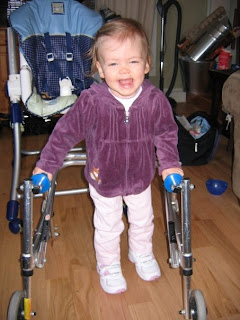Honestly, we were so embarrassed asking anyone for anything that we didn't fill out the forms.. our social worker filled it out for us. The first thing was Special Services at Home (SSAH) http://www.children.gov.on.ca/htdocs/English/topics/specialneeds/specialservices/index.aspx from the Ministry of Community and Social Services. This is flexible funding that can be used for a variety of things such as hiring a care worker to help you in the house or just respite services (meaning just give the family a BREAK)
I told the social worker - we make okay money.. we don't *need* to get funding.. she stopped me there. She said, you have no idea how much more money you will spend on your child than the average parent. Think about all the additional expenses you will have in terms of equipment, daily living aids, specialized clothing, activities requiring you to hire a personal teacher or helper (i.e. her own gymnastics teacher instead of being in a group class)
I typically HATE using statistics if I don't know where the sources are from and what the methodology is BUT the Canadian Council on Social Development tells me that it costs an average of $166, 549 to raise a girl to age 18 ($166,972 for boys who eat more) http://www.ccsd.ca/factsheets/family/ So that is roughly $9200 a year to raise my girl (yes, I'm rounding down - just go with me)
In contrast, the added cost (above and beyond the average) to raise a disabled child in Canada can be upwards of $8000 a year. http://www.ncbi.nlm.nih.gov/pmc/articles/PMC1802121/. So that would put the grand total up to $310,549 for 18 years. I've read other articles that estimate the cost to be 3-4 times average, so that would be in the $500,000 - $660,000 range!
I certainly don't have that kind of dough lying around in my back pocket...
Okay - so I can't help but plug my organization but Statistics Canada has a publication and data tables from 2001 on Children with disabilities and their families http://www.statcan.gc.ca/pub/89-586-x/index-eng.htm. Let's talk about the opportunity cost of caring for a child with a disability. Statcan mentions a few reasons why the child may have an economic impact on a family - things like; parent working fewer hours, changing their work hours, not taken a job in order to care for the child, quit working, and turned down a promotion or a better job. In some cases, the parents need to devote their entire lives all day every day to caring for their children - how are they making ends meet?
So how does the Canadian government help? Well there is:
- Disability Tax Credit for which you must fill out the Disability Tax Credit Certificate http://www.cra-arc.gc.ca/E/pbg/tf/t2201/README.html. Do this as SOON as you get your diagnosis as it's a pre-requisite for a lot of other services. The credit on the tax return is a huge benefit - very worth while.
- Medical tax credits. http://www.cra-arc.gc.ca/E/pub/tg/rc4064/rc4064-e.html#P193_7724 You can deduct medical expenses (up to $10,000 per dependent) and can even claim moving expenses if you are moving to a more accessible home.
- Child Disability Benefit (CDB) http://www.cra-arc.gc.ca/bnfts/dsblty-eng.html is a tax-free monthly payment per child (up to $205.83 per month depending on family net income) Once you send in the tax certificate mentioned above, this will be sent to you automatically. As an aside (and kudos to my government - thanks guys) I didn't send in my daughter's form until she was 2 and they sent me a cheque for all the money I would have received since she was born. That rocked.. thanks Canada.
- Registered Disability Savings Plan (RDSP) http://www.cra-arc.gc.ca/tx/ndvdls/tpcs/rdsp-reei/menu-eng.html is
- Canada Disability Savings Grant is new program where the government will match your investment into the RSDP as follows: The amount of the CDSG is based on the beneficiary’s family income as follows:
Beneficiary's
family incomeContribution Grant Maximum $77,664*
or lessOn the first $500 $3 for every $1 contributed $1,500 On the next $1,000 $2 for every $1 contributed $2,000 More than
$77,664*On the first $1,000 $1 for every $1 contributed $1,000 - Canada Disability Savings Bond is where the government will contribute to the individual's RDSP if their family income is less than $21,816
There are many other sources of funding - one that we use very often is the Ontario Assistive Devices Program or ADP http://www.health.gov.on.ca/english/public/program/adp/adp_mn.html. They will pay a portion of the device (orthotics, prosthetics, walking aids, wheelchairs, etc.) You would then submit the remainder of the cost to your insurance company (if you were lucky enough to have that through your work or otherwise) or pay out of pocket.



